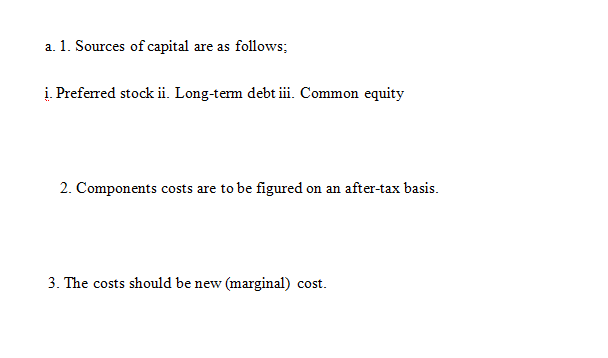What sources of capital should be included when you estimate Jana’s weighted average cost of capital?
Case Study Questions
During the last few years, Jana Industries has been too constrained by the high cost of capital to make many capital investments. Recently, though, capital costs have been declining, and the company has decided to look seriously at a major expansion program proposed by the marketing department. Assume that you are an assistant to Leigh Jones, the financial vice president. Your first task is to estimate Jana’s cost of capital. Jones has provided you with the following data, which she believes may be relevant to your task:
• The firm’s tax rate is 40%.
• The current price of Jana’s 12% coupon, semiannual payment, no callable bonds with 15 years remaining to maturity is $1,153.72. Jana does not use short-term interest-bearing debt on a permanent basis. New bonds would be privately placed with no flotation cost.
• The current price of the firm’s 10%, $100 par value, quarterly dividend, perpetual preferred stock is $116.95. Jana would incur flotation costs equal to 5% of the proceeds on a new issue.
• Jana’s common stock is currently selling at $50 per share. Its last dividend D0 was $3.12, and dividends are expected to grow at a constant rate of 5.8% in the foreseeable future. Jana’s beta is 1.2, the yield on T-bonds is 5.6%, and the market risk premium is estimated to be 6%. For the own-bond-yield-plus-judgmental-risk-premium approach, the firm uses a 3.2% risk premium.
• Jana’s target capital structure is 30% long-term debt, 10% preferred stock, and 60% common equity.
To help you structure the task, Leigh Jones has asked you to answer the following questions.
a. (1) What sources of capital should be included when you estimate Jana’s weighted average cost of capital?
(2) Should the component costs be figured on a before-tax or an after-tax basis?
(3) Should the costs be historical (embedded) costs or new (marginal) costs?
b. What is the market interest rate on Jana’s debt, and what is the component cost of this debt for WACC purposes?
c. (1) What is the firm’s cost of preferred stock?
(2) Jana’s preferred stock is riskier to investors than its debt, yet the preferred stock’s yield to investors is lower than the yield to maturity on the debt. Does this suggest that you have made a mistake? (Hint: Think about taxes.)
d. (1) What are the two primary ways companies raise common equity?
(2) Why is there a cost associated with reinvested earnings? (3) Jana doesn’t plan to issue new shares of common stock. Using the CAPM approach, what is Jana’s estimated cost of equity?
Answer preview what sources of capital should be included when you estimate Jana’s weighted average cost of capital?
APA
335 words

